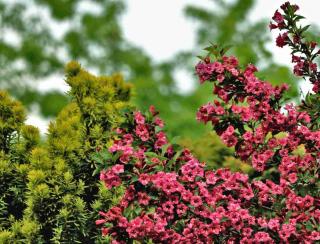

Why not go for a four-seasons hedge? Bored with drab monochrome conifers? Bring a bundle of delight to the neighborhood with a mixed hedge of ornamental flower, leaf and fruit shrubs.
It will give you an ever-changing scenery as seasons come and go.
Read our other articles related to hedges:
 Your own particular tastes will guide you to favor shrubs either for their blooming (colors, season, duration), leafage (green or purple, mottled or homogeneous, golden or silver, and all the fall hues like dark green, scarlet or copper), fruits (ornamental or bird-pleasing), or their fragrance (leaf smell or flowers).
Your own particular tastes will guide you to favor shrubs either for their blooming (colors, season, duration), leafage (green or purple, mottled or homogeneous, golden or silver, and all the fall hues like dark green, scarlet or copper), fruits (ornamental or bird-pleasing), or their fragrance (leaf smell or flowers).
Personally, among the fragrant bushes my preference goes to winter honeysuckle, Daphne which has nice wood and mock-orange. Some shrubs like caryopteris also have very fragrant leaves. If you love butterflies, call them over with shrubs that have nectar-laden flowers (lilac, caryopteris). Some horticulture stores offer “ready-plant” hedge kits for four-seasons hedges, including for instance tamarisk, forsythia, red currant bushes, weigela, snowberry and guelder-rose.
The ideal time to plant a hedge is around the feast of Saint Catherine on November 25th for shrubs sold with bare roots, but shrubs purchased in pots or containers can be planted all year round, except when it freezes or during dry spells.
Each hole must measure more or less 16 x 16 x 16 inches (40 x 40 x 40 cm). Spacing depends on the variety: from 20 inches (50 cm) up to 6 ½ feet (2 meters). If your soil has lots of clay, lighten it towards the bottom to ensure drainage with gravel, broken pot shards or expanded clay pebbles. Cut short roots that stick out and broken branches.
If it doesn’t rain after planting, water your hedge abundantly. To slow weed growth, mulch along the hedge. Prune new growth during the first year to stimulate their vigor, but only after flowering. After that, pruning mostly focuses on keeping a harmonious balanced shape.
Pierrick Le Jardinier